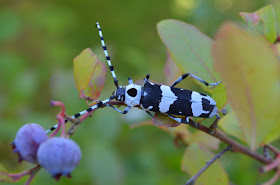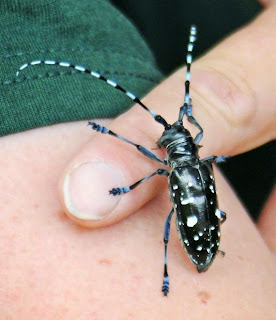We recently visited friends in Vancouver Island, British Columbia who have a mini-farm with chickens and sheep, an orchard with apples, peaches, sugarplums, blueberries, kiwis, and figs, plus a show-stopping garden full of tomatoes, peas, beans, squash, lettuces, artichoke, and everything else. Oh, and dinner plate dahlias. I get lost in their garden every time I visit.
During my tour through the blueberry patch (in between popping blueberries into my mouth), I came across a fascinating bug.
I believe it was dead when I took these pictures. I nudged it with my finger and it didn't react. That's why I was able to run to the house and get my camera, and still find it in the same place. That also explains why its back left leg is bending the wrong way. But I think it's really pretty. Do you know what it is?
--Rachel
Hey Way,
I have to admit, I saw this and my heart started beating really fast. This is a longhorn beetle, so-named because their antennae are often longer than their bodies. They are a boring insect, and generally attack trees. This one looks a lot like an Asian Longhorn beetle, which would be really, really bad. Luckily, it's not. It's a North American variety, called a Banded Alder Borer, and they generally attack trees that are already on the ground. Therefore they aren't really pests. They like to lay eggs on the creases of alder trees (and some others). The eggs hatch and then bore under the bark and into the wood. The adults feed on flowers, which is likely why it was in the garden. Knowing that it's a Banded Alder Borer means that it's okay to marvel at how beautiful it is! You can find this species on the western coast all the way from Alaska down to Central and Southern California and New Mexico.
This is not an Asian Longhorn Beetle, but it is important to be able to identify the differences.
Asian Longhorn Beetles are a serious pest. They were discovered in Brooklyn in 1996. Shortly afterward, they were all around New York. Several trees in Central Park had to be removed due to infestations. Since then, they've spread to New Jersey, Chicago, Ohio and Massachusetts. They found 6 infested trees in Boston, directly across the street from the oldest arboretum in the United States. Massachusetts has removed at least 28,000 trees so far. Ohio is at serious risk, due to how much of the economy depends on the trees. They have invaded Britain, Germany and Austria. They have been discovered in warehouses throughout the country, including the British Columbia and Washington State. Luckily, fantastic warehouse workers have caught them before they were allowed to get out. This pest chews up a lot of deciduous trees. Think the dreaded bark beetle in the west, except that they aren't picky about trees: ash, maple, birch, elm, poplar, willow, and several others.
People who live in New England should report any sightings of this insect. This site provides a lot of good information. The "Spot It" tab has a bunch of pictures and information on how to identify both the beetle and the damage. You can also report a sighting. http://beetlebusters.info/
Identifying the Beetle:
The Asian Longhorn Beetle looks a lot like this one, in that they are zebra striped. They are shiny black beetles with white stripes/spots on their bodies and on their antennae too. The antennae are longer than most other beetles' antennae, and can even be longer than their body. The Banded Alder Borer, however, has a white thorax with a big black dot. The Asian Longhorn has a black thorax. The thorax is the segment right below the head. The neck, if you will.
Asian Longhorn Borer:
Not One: Here's the lovely gal you discovered, a Banded Alder Borer:
See the difference?
Here's another picture of an Asian Longhorn Beetle:
On the eastern coasts, you won't see the Banded Alder Borer, but there are some other lookalikes. This site does a good job of helping you identify them.
http://www.uvm.edu/albeetle/identification/index.html#alderborer
But if you are in an infested area, and you see something you think could be an Asian Longhorn, I'd just go ahead and report it anyway. It can't hurt and it might save all the trees in your neighborhood.
And people throughout the country should have a general idea what to look for. We really don't want these spreading.
Pages
▼
Saturday, August 11, 2012
Sunday, August 5, 2012
Sticky Webbing on Zinnias & Fennel
Amy:
I love zinnias. Pacific Northwesterners don't seem to grow them much, but to me they are the epitome of summer. Little globes in crayola colors. Besides, they remind me of Val's garden, which is pretty much the flower garden of my dreams. I planted mine in the front yard, so I see them every morning when I leave for work.
Even though zinnias are annuals, I want to make them last as long as possible. So I've kept a close watch on them. I noticed some very fine webbing on the flower petals:
In one case, there was even a dew-like substance clinging to the webbing:
There is also some leaf damage:
In the back yard, quite a long way away from my zinnias and on the opposite side of the house, I may have the same problem on my fennel. Serious dewey webbing:
That thing in the middle of this photo was a dead moth, I think.
I know that I have aphids on the fennel, but I don't think aphids make webs like this. So I'm guessing it's something in addition. I looked for the actual insect but either it's too small to see or it hides during the day when the sun is out.
What do you think?
Rachel
I love zinnias. Pacific Northwesterners don't seem to grow them much, but to me they are the epitome of summer. Little globes in crayola colors. Besides, they remind me of Val's garden, which is pretty much the flower garden of my dreams. I planted mine in the front yard, so I see them every morning when I leave for work.
Even though zinnias are annuals, I want to make them last as long as possible. So I've kept a close watch on them. I noticed some very fine webbing on the flower petals:
In one case, there was even a dew-like substance clinging to the webbing:
There is also some leaf damage:
In the back yard, quite a long way away from my zinnias and on the opposite side of the house, I may have the same problem on my fennel. Serious dewey webbing:
That thing in the middle of this photo was a dead moth, I think.
I know that I have aphids on the fennel, but I don't think aphids make webs like this. So I'm guessing it's something in addition. I looked for the actual insect but either it's too small to see or it hides during the day when the sun is out.
What do you think?
Rachel












